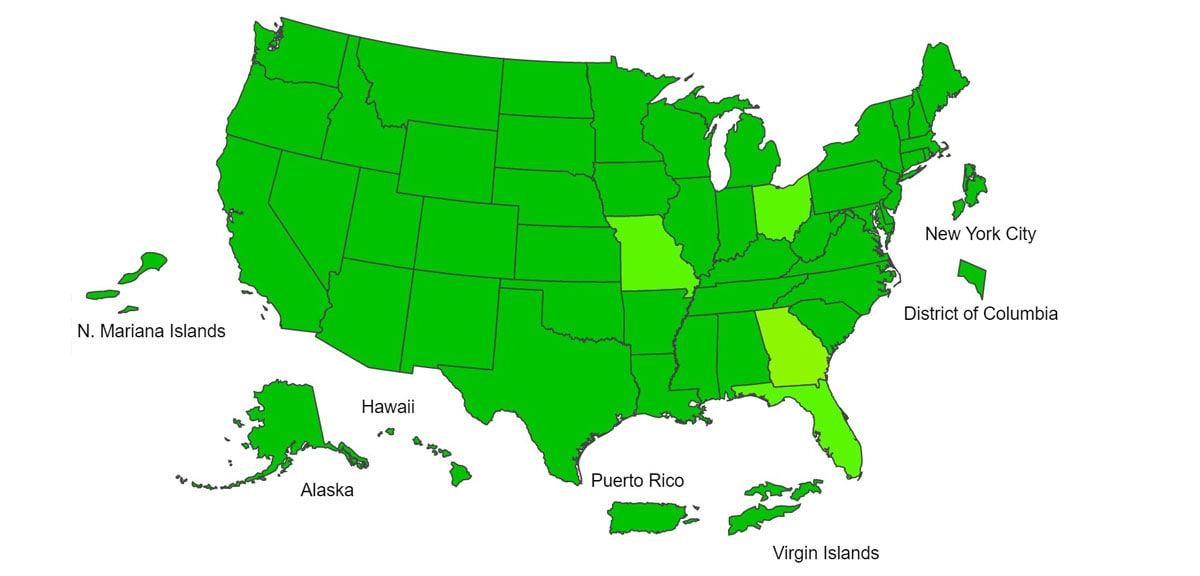FluView Summary ending on May 22, 2021

Note: CDC is tracking the COVID-19 pandemic in a weekly publication called COVID Data Tracker Weekly Review.
All data are preliminary and may change as more reports are received.
A description of the CDC influenza surveillance system, including methodology and detailed descriptions of each data component is available on the surveillance methods page.
Additional information on the current and previous influenza seasons for each surveillance component are available on FluView Interactive.
Seasonal influenza activity in the United States remains lower than usual for this time of year.
Viruses
Severe Disease
All data are preliminary and may change as more reports are received.
A description of the CDC influenza surveillance system, including methodology and detailed descriptions of each data component is available on the surveillance methods page.
Additional information on the current and previous influenza seasons for each surveillance component are available on FluView Interactive.
Key Points
- Flu activity is unusually low at this time.
- One human infection with an influenza A(H1N2) variant (A(H1N2)v) virus was reported this week. This is the first influenza A(H1N2)v virus identified in the United States in 2021.
- An annual flu vaccine is the best way to protect against flu and its potentially serious complications.
- There are also flu antiviral drugs that can be used to treat flu illness.
U.S. Virologic Surveillance:
Clinical Laboratories
The results of tests performed by clinical laboratories nationwide are summarized below. Data from clinical laboratories (the percentage of specimens tested that are positive for influenza) are used to monitor whether influenza activity is increasing or decreasing.
| Week 20 | Data Cumulative since September 27, 2020 (Week 40) |
|
|---|---|---|
| No. of specimens tested | 20,091 | 1,081,671 |
| No. of positive specimens (%) | 24 (0.1%) | 1,899 (0.2%) |
| Positive specimens by type | ||
| Influenza A | 16 (66.7%) | 713 (37.5%) |
| Influenza B | 8 (33.3%) | 1,186 (62.5%) |
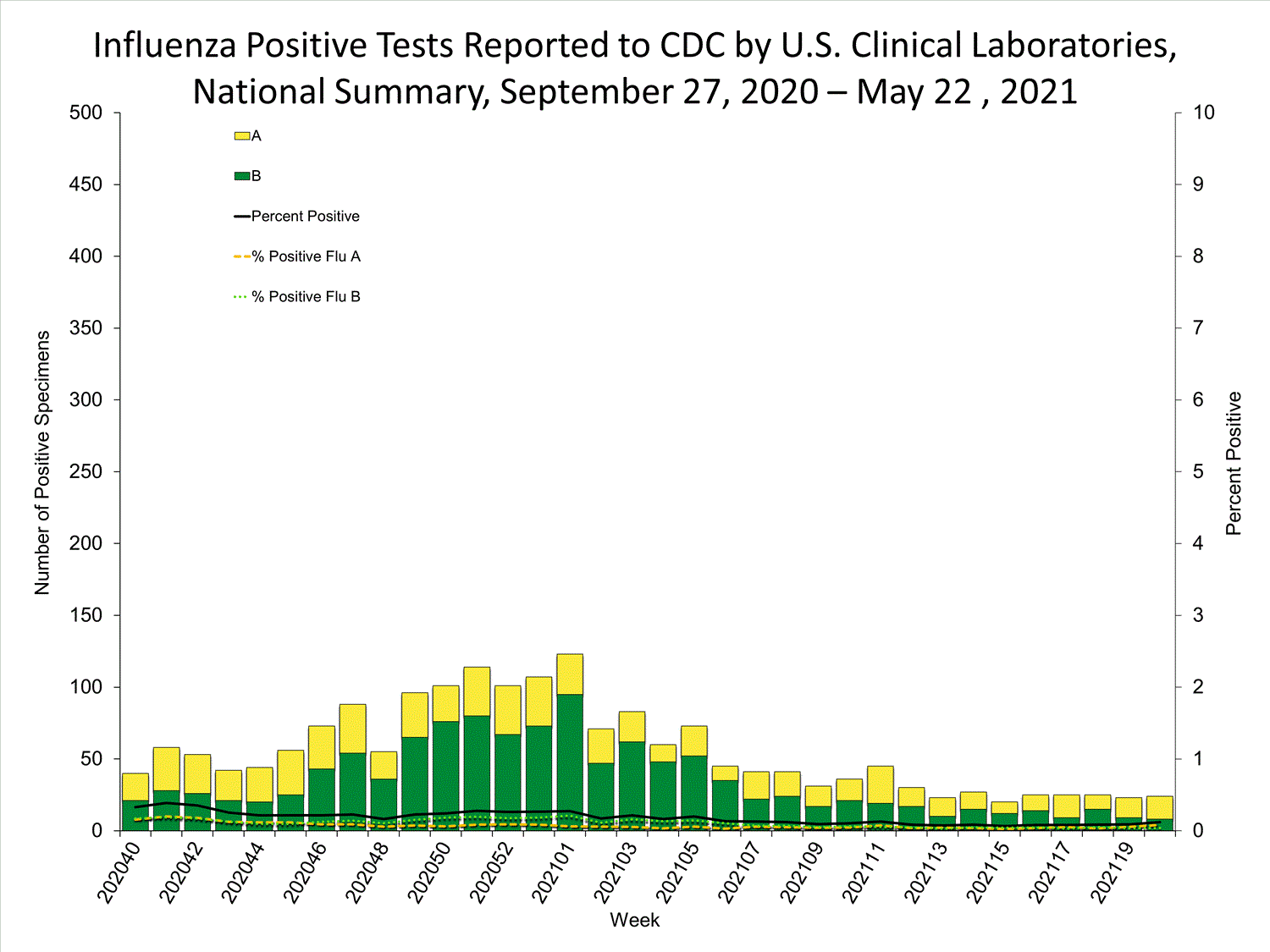
View Chart Data | View Full Screen
Public Health Laboratories
The results of tests performed by public health laboratories nationwide are summarized below. Data from public health laboratories are used to monitor the proportion of circulating viruses that belong to each influenza subtype/lineage.
| Week 20 | Data Cumulative since September 27, 2020 (Week 40) |
|
|---|---|---|
| No. of specimens tested | 8,811 | 494,951 |
| No. of positive specimens | 1 | 251 |
| Positive specimens by type/subtype | ||
| Influenza A | 1 (100.0%) | 154 (61.4%) |
| (H1N1)pdm09 | 0 | 18 (45.0%) |
| H3N2 | 0 | 21 (52.5%) |
| H3N2v | 0 | 1 (2.5%) |
| Subtyping not performed | 1 | 114 |
| Influenza B | 0 | 97 (38.6%) |
| Yamagata lineage | 0 | 8 (40.0%) |
| Victoria lineage | 0 | 12 (60.0%) |
| Lineage not performed | 0 | 77 |
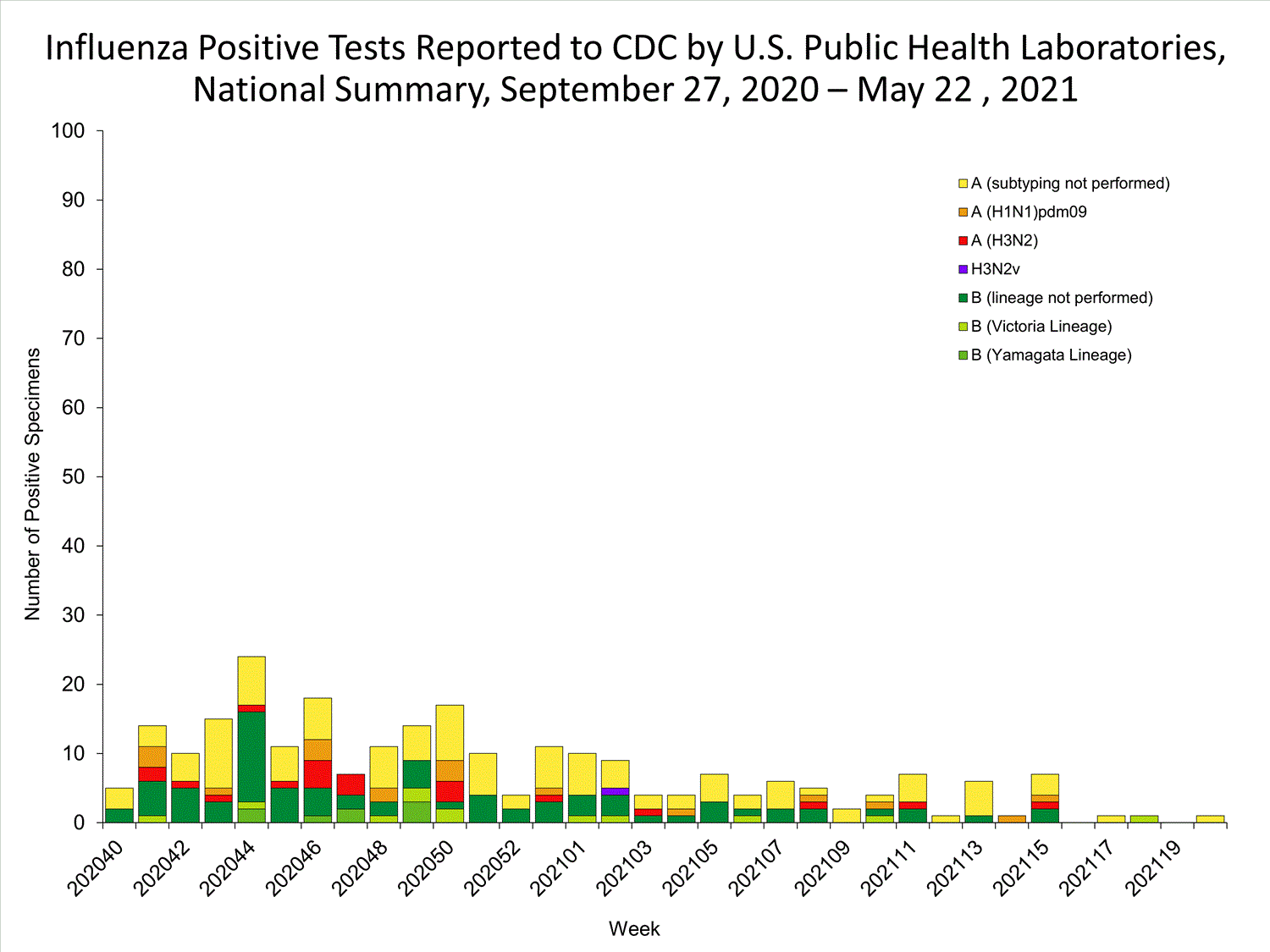
View Chart Data | View Full Screen
Novel Influenza A Virus
One human infection with an influenza A(H1N2) variant (A(H1N2)v) virus was reported by Ohio. The patient is <18 years of age, was not hospitalized, and has completely recovered from their illness. Investigation into the source of the infection revealed that the patient lives on a farm with swine present. No human-to-human transmission of A(H1N2)v virus has been identified associated with this patient. This is the first influenza A(H1N2)v virus identified in the United States that occurred in 2021.
Early identification and investigation of human infections with novel influenza A viruses are critical so that the risk of infection can be more fully understood and appropriate public health measures can be taken. Additional information on influenza in swine, variant influenza infection in humans, and strategies to interact safely with swine can be found at http://www.cdc.gov/flu/swineflu/index.htm.
Additional information regarding human infections with novel influenza A viruses can be found at http://gis.cdc.gov/grasp/fluview/Novel_Influenza.html.
Additional virologic surveillance information for current and past seasons:
Surveillance Methods | FluView Interactive: National, Regional, and State Data or Age Data
Influenza Virus Characterization
CDC performs genetic and antigenic characterization of U.S. viruses submitted from state and local health laboratories using Right Size Roadmap submission guidance. These data are used to compare how similar the currently circulating influenza viruses are to the reference viruses used for developing new influenza vaccines and to monitor evolutionary changes that continually occur in circulating influenza viruses. CDC also tests susceptibility of influenza viruses to antiviral medications including the neuraminidase inhibitors (oseltamivir, zanamivir, and peramivir) and the PA endonuclease inhibitor baloxavir.
CDC genetically characterized 10 influenza viruses collected in the U.S. from September 27, 2020, to May 22, 2021.
Influenza A Viruses
- A (H1N1)pdm09: 2 A(H1N1)pdm09 viruses were genetically characterized. Phylogenetic analysis of the HA gene of these viruses showed that 1(50%) belonged to the 5A1 subclade of the 6B.1A clade, which is the same subclade as the 2020-21 NH vaccine candidate, A/Hawaii/70/2019, while the other 1(50%) belonged to the 5B subclade.
- A (H3N2): 4 A(H3N2) viruses were genetically characterized. Phylogenetic analysis of the HA genes of these viruses showed that all 4(100%) belonged to the 3C.2a clade, 1b2a subclade. The 2020-21 NH vaccine candidate, A/Hong Kong/45/2019, also belongs to the 3C.2a clade but is in the subclade 1b1b.
Influenza B Viruses
- B/Victoria: 4 B/Victoria viruses were genetically characterized. Phylogenetic analysis of the HA gene of these viruses showed that 4(100%) belonged to the V1A.3 clade, which is the same as the 2020-21 NH vaccine candidate, B/Washington/02/2019.
- B/Yamagata: There were no B/Yamagata viruses genetically characterized during this period.
CDC antigenically characterizes a subset of influenza viruses by hemagglutination inhibition (HI) or neutralization based assay such as Focus Reduction (FRA) or High-content imaging neutralization test (HINT). Antigenic drift is evaluated by comparing antigenic properties of cell- and egg-propagated reference viruses representing currently recommended vaccine components with those of cell-propagated circulating viruses. CDC antigenically characterized 9 influenza viruses collected in the United States from September 27, 2020, to May 22, 2021.
Influenza A Viruses
- A(H1N1)pdm09: Two A(H1N1)pdm09 viruses were antigenically characterized by HI with ferret antisera, 2(100%) were antigenically similar (reacting to titers that were within 4-fold of the homologous virus titer) to the cell-propagated A/Hawaii/70/2019-like reference virus representing the A(H1N1)pdm09 component for the 2020-21 Northern Hemisphere cell-based influenza vaccines. When compared to the egg-based A/Guangdong-Maonan/1536/2019-like reference virus representing the A(H1N1)pdm09 component for the 2020-21 Northern Hemisphere egg-based influenza vaccines, 2(100%) were antigenically similar.
- A(H3N2): Three A(H3N2) viruses were antigenically characterized by HINT with ferret antisera, and 1 (33%) was antigenically similar (reacting to titers that were within 4-fold of the homologous virus titer) to the cell-propagated A/Hong Kong/45/2019-like reference virus representing the A(H3N2) component for the 2020-21 Northern Hemisphere cell-based influenza vaccines. When compared to the egg-based A/Hong Kong/2671/2019-like reference virus representing the A(H3N2) component for the 2020-21 Northern Hemisphere egg-based influenza vaccines, none were antigenically similar.
Influenza B Viruses
- B/Victoria: Four B/Victoria lineage viruses, each from the V1A.3 subclade, were antigenically characterized by HI with ferret antisera, and four (100%) were antigenically similar to the cell- and egg-propagated B/Washington/02/2019-like reference viruses representing the B/Victoria component for the 2020-21 Northern Hemisphere cell and egg-based influenza vaccines.
CDC assesses susceptibility of influenza viruses to the antiviral medications oseltamivir, zanamivir, peramivir, and baloxavir using next generation genomic sequence analysis supplemented by laboratory assays. Viruses collected in the U.S. since September 27, 2020 were susceptible to the antiviral medications tested, as follows:
| Antiviral Medication | Total Viruses |
A/H1 | A/H3 | B/Victoria | B/Yamagata | ||
|---|---|---|---|---|---|---|---|
| Neuraminidase Inhibitors |
|||||||
| Oseltamivir | Viruses Tested |
10 | 2 | 4 | 4 | 0 | |
| Reduced Inhibition |
(0.0%) | (0.0%) | (0.0%) | (0.0%) | (0.0%) | ||
| Highly Reduced Inhibition |
(0.0%) | (0.0%) | (0.0%) | (0.0%) | (0.0%) | ||
| Peramivir | Viruses Tested |
10 | 2 | 4 | 4 | 0 | |
| Reduced Inhibition |
(0.0%) | (0.0%) | (0.0%) | (0.0%) | (0.0%) | ||
| Highly Reduced Inhibition |
(0.0%) | (0.0%) | (0.0%) | (0.0%) | (0.0%) | ||
| Zanamivir | Viruses Tested |
10 | 2 | 4 | 4 | 0 | |
| Reduced Inhibition |
(0.0%) | (0.0%) | (0.0%) | (0.0%) | (0.0%) | ||
| Highly Reduced Inhibition |
(0.0%) | (0.0%) | (0.0%) | (0.0%) | (0.0%) | ||
| PA Endonuclease Inhibitor | Baloxavir | Viruses Tested |
10 | 2 | 5 | 4 | 0 |
| Reduced Susceptibility |
(0.0%) | (0.0%) | (0.0%) | (0.0%) | (0.0%) | ||
Outpatient Illness Surveillance
Please note, the U.S. Outpatient Influenza-like Illness Surveillance Network (ILINet) monitors outpatient visits for influenza-like illness (ILI), not laboratory-confirmed influenza, and will capture visits due to other respiratory pathogens, such as SARS-CoV-2, that present with similar symptoms. In addition, health care-seeking behaviors have changed dramatically during the COVID-19 pandemic. Many people are accessing the health care system in alternative settings, which may or may not be captured as a part of ILINet. Therefore, ILI data, including ILI activity levels, should be interpreted with caution. It is particularly important at this time to evaluate syndromic surveillance data, including that from ILINet, in the context of other sources of surveillance data to obtain a complete and accurate picture of both influenza and COVID-19 activity. CDC is tracking the COVID-19 pandemic in a weekly publication called COVID Data Tracker Weekly Review.
ILINet
Nationwide during week 20, 1.3% of patient visits reported through ILINet were due to ILI. This percentage is below the national baseline of 2.6%.
.
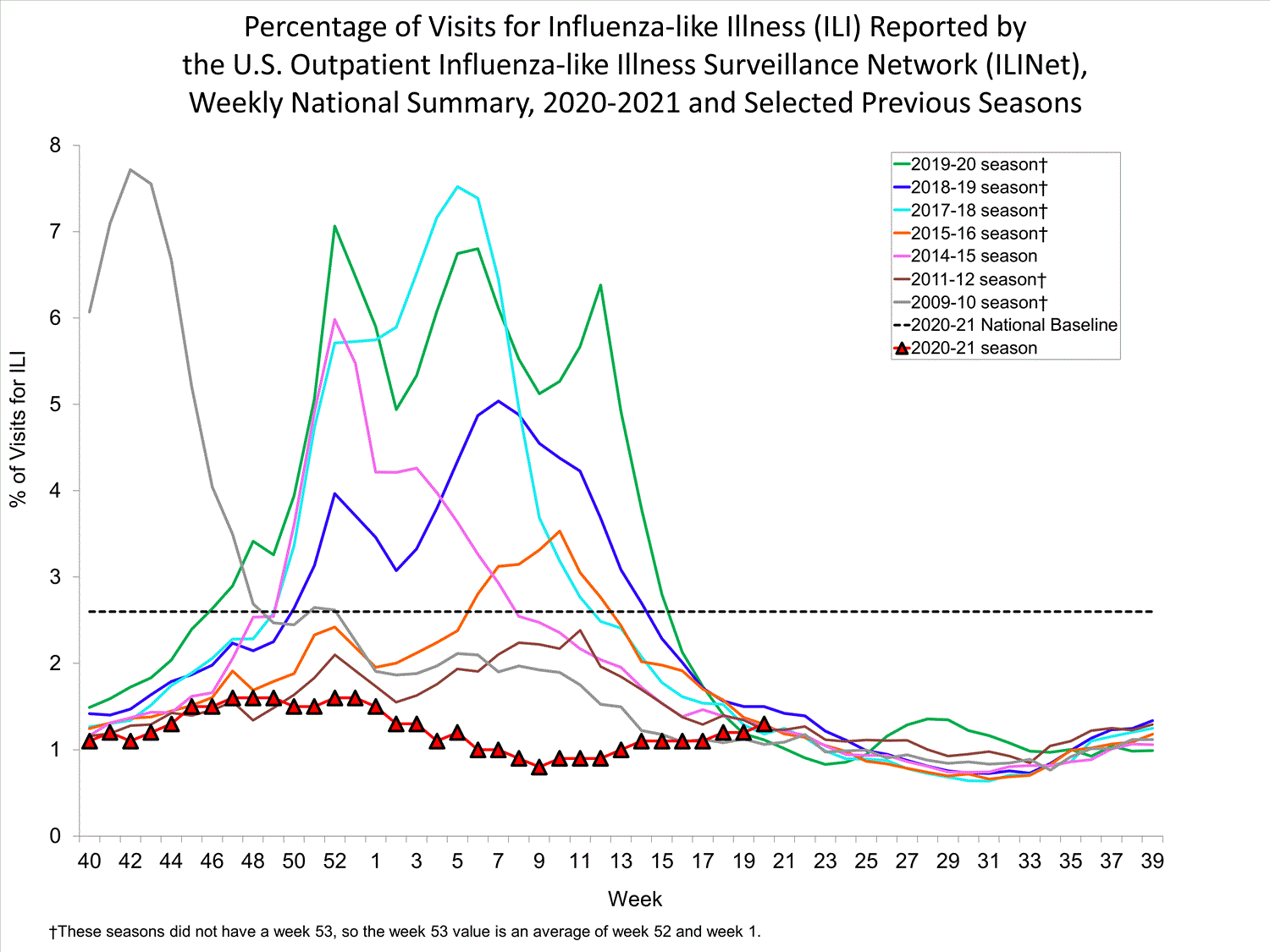
View Chart Data (current season only) | View Full Screen
During week 20, compared with week 19, the percentage of visits for ILI increased for one region (Region 6) and remained stable (change of ≤ 0.1%) in the remaining nine regions. All regions reported percentages of outpatient visits for ILI below their region-specific baselines.
ILI Visits by Age Group
About 65% of ILINet providers provide both the number of patient visits for ILI, and the total number of patient visits for the week broken out by age group. Data from this subset of providers are used to calculate the percentages of patient visits for ILI by age group. The percentages of visits for ILI reported in ILINet in week 20 continued to increase for one age group (0–4 years) and remained stable (change of ≤0.1%) for the remaining age groups (5–24 years, 25–49 years, 50–64 years, and 65 years and older) compared with week 19. There has been an increasing trend among persons aged 0–4 years and 5–17 years, while the remaining age groups have experienced a stable trend.

View Chart Data | View Full Screen
ILI Activity Map
Data collected in ILINet are used to produce a measure of ILI activity* by state/jurisdiction and Core Based Statistical Areas (CBSA).
| Activity Level | Number of Jurisdictions | Number of CBSAs | ||
|---|---|---|---|---|
| Week 20
(Week ending |
Week 19
(Week ending |
Week 20
(Week ending |
Week 19
(Week ending |
|
| Very High | 0 | 0 | 0 | 0 |
| High | 0 | 0 | 0 | 1 |
| Moderate | 0 | 0 | 5 | 6 |
| Low | 0 | 0 | 27 | 32 |
| Minimal | 55 | 55 | 564 | 587 |
| Insufficient Data | 0 | 0 | 333 | 303 |
*Data collected in ILINet may disproportionally represent certain populations within a jurisdiction or CBSA, and therefore, may not accurately depict the full picture of influenza activity for the entire jurisdiction or CBSA. Differences in the data presented here by CDC and independently by some health departments likely represent differing levels of data completeness with data presented by the health department likely being the more complete.
Additional information about medically attended visits for ILI for current and past seasons:
Surveillance Methods | FluView Interactive: National, Regional, and State Data or ILI Activity Map
Geographic Spread of Influenza as Assessed by State and Territorial Epidemiologists
The geographic spread of influenza as reported by state and territorial epidemiologists indicates geographic spread of influenza viruses but does not measure the severity of influenza activity. Due to the impact of COVID-19 on ILI surveillance, and the fact that the state and territorial epidemiologists report relies heavily on ILI activity, reporting for this system will be suspended for the 2020-21 influenza season. Data from previous seasons is available on FluView Interactive.
Additional geographic spread surveillance information for current and past seasons:
Surveillance Methods | FluView Interactive
Influenza-Associated Hospitalizations:
The Influenza Hospitalization Surveillance Network (FluSurv-NET) conducts population-based surveillance for laboratory-confirmed influenza-related hospitalizations in select counties in 14 states and represents approximately 9% of the U.S. population.
Between October 1, 2020, and April 30, 2021, FluSurv-NET sites in 14 states reported 224 laboratory confirmed influenza hospitalizations for an overall cumulative hospitalization rate of 0.8 per 100,000 population. This is lower than rates for any season since routine data collection began in 2005, including the low severity 2011-12 season. The end-of-season rate is one-tenth the rate as during the 2011-12 season. Due to low case counts, only overall cumulative rates for the entire network are being reported this season.
Additional hospitalization surveillance information for current and past seasons and additional age groups:
Surveillance Methods | FluView Interactive: Rates by Age or Patient Characteristics
National Center for Health Statistics (NCHS) Mortality Surveillance
Based on NCHS mortality surveillance data available on May 27, 2021, 9.5% of the deaths that occurred during the week ending May 22, 2021 (week 20), were due to pneumonia, influenza, and/or COVID-19 (PIC). This percentage is above the epidemic threshold of 6.3% for week 20. Among the 1,811 PIC deaths reported for this week (week 20), 1,074 had COVID-19 listed as an underlying or contributing cause of death on the death certificate, and one listed influenza, indicating that current PIC mortality is due primarily to COVID-19 and not influenza. The data presented are preliminary and may change as more data are received and processed.
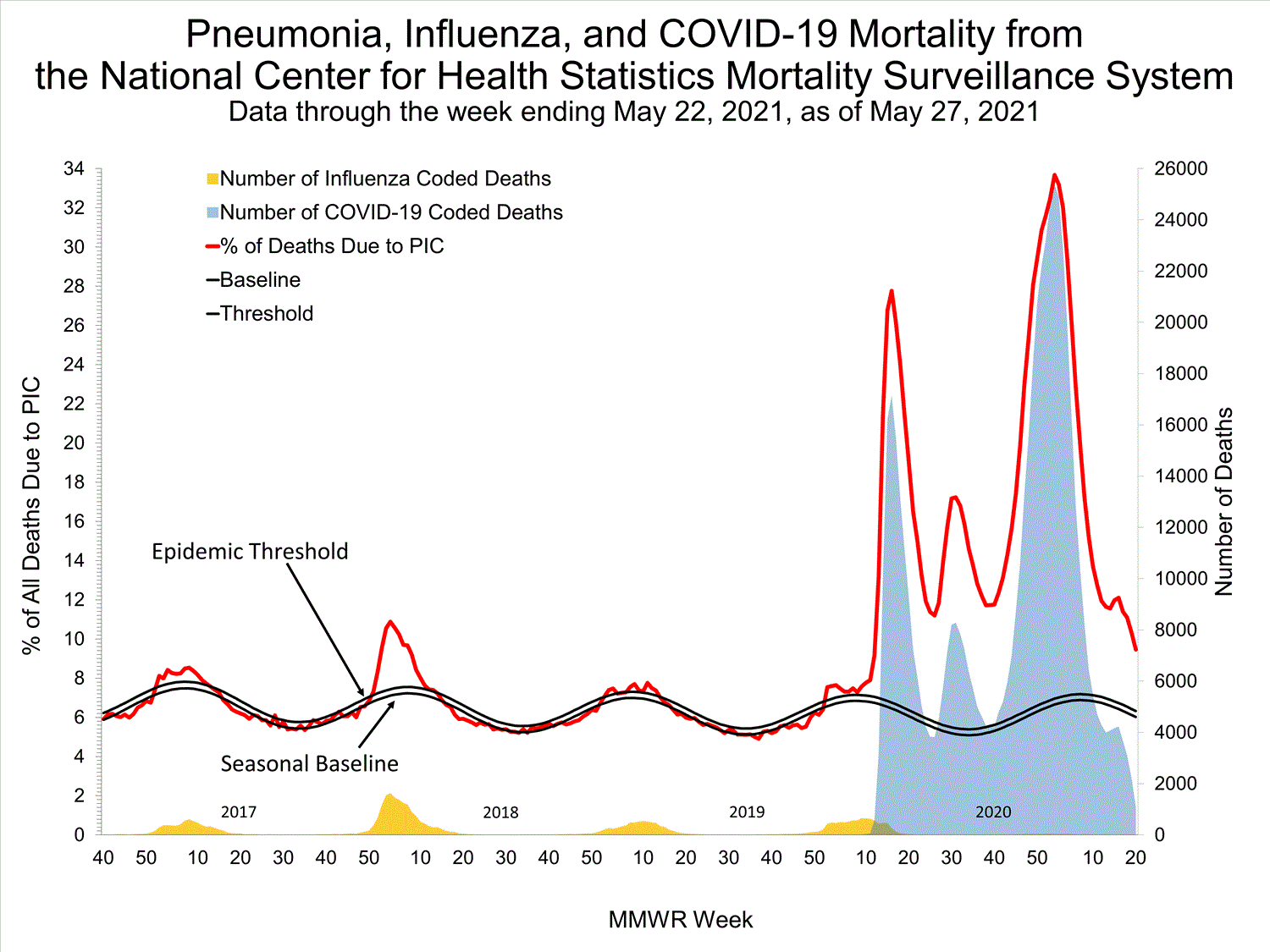
View Chart Data | View Full Screen
Additional pneumonia and influenza mortality surveillance information for current and past seasons:
Surveillance Methods | FluView Interactive
Influenza-Associated Pediatric Mortality
A total of one influenza-associated pediatric death occurring during the 2020-2021 season has been reported to CDC.
One influenza-associated pediatric death occurring during the 2019-2020 season was reported to CDC during week 20 of the 2020-2021 season. This death was associated with an influenza A(H1N1)pdm09 virus and occurred during week 2 of 2020 (the week ending January 11, 2020). The total number of pediatric deaths occurring during the 2019-2020 season is 199.
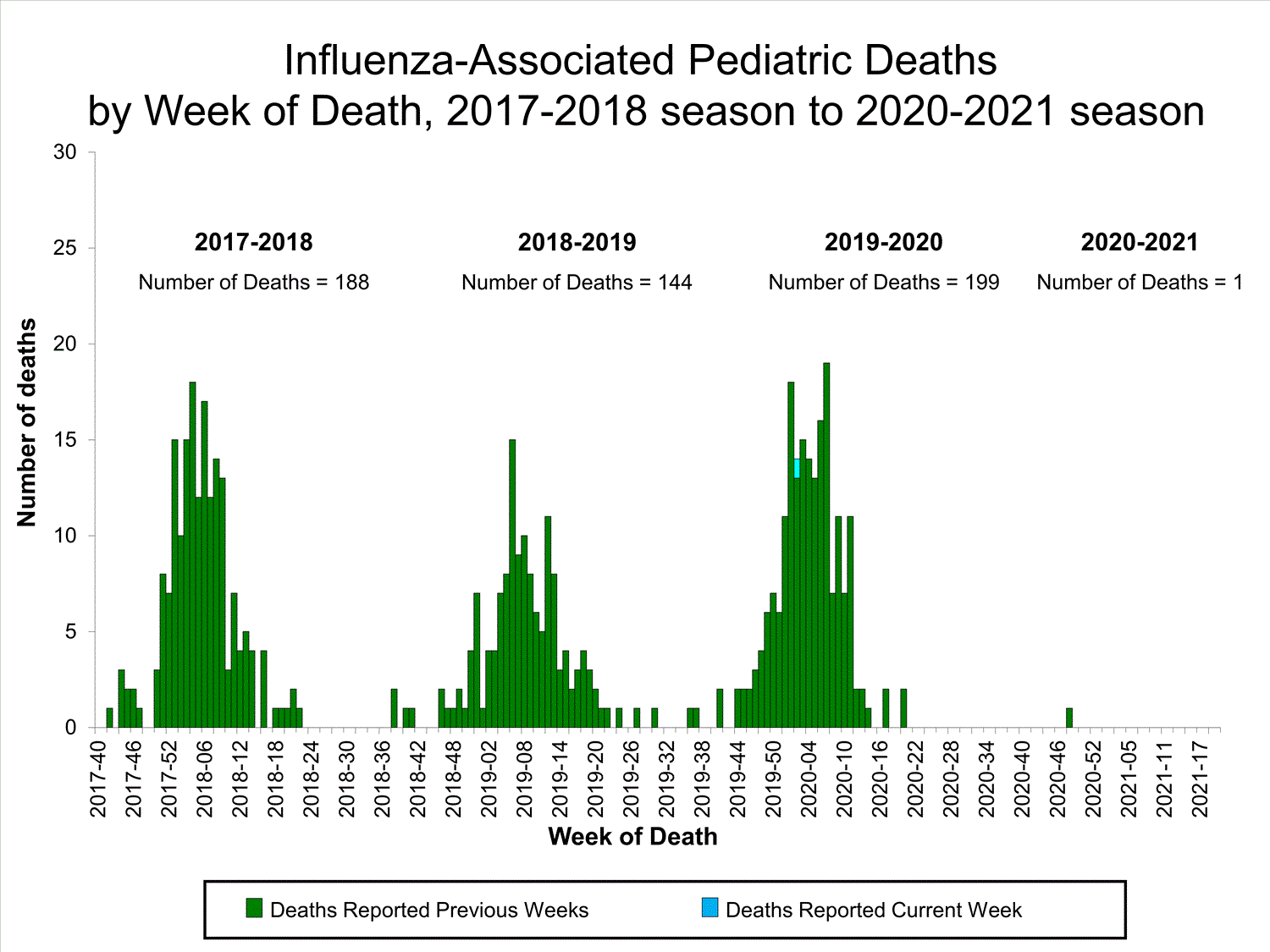
Additional pediatric mortality surveillance information for current and past seasons:
Surveillance Methods | FluView Interactive
Additional National and International Influenza Surveillance Information
FluView Interactive: FluView includes enhanced web-based interactive applications that can provide dynamic visuals of the influenza data collected and analyzed by CDC. These FluView Interactive applications allow people to create customized, visual interpretations of influenza data, as well as make comparisons across flu seasons, regions, age groups and a variety of other demographics.
National Institute for Occupational Safety and Health: Monthly surveillance data on the prevalence of health-related workplace absenteeism among full-time workers in the United States are available from NIOSH.
U.S. State and local influenza surveillance: Select a jurisdiction below to access the latest local influenza information.
World Health Organization:
Additional influenza surveillance information from participating WHO member nations is available through
FluNetexternal icon and the Global Epidemiology Reports.external icon
WHO Collaborating Centers for Influenza:
Australiaexternal icon, Chinaexternal icon, Japanexternal icon, the United Kingdomexternal icon, and the United States (CDC in Atlanta, Georgia)
Europe:
The most up-to-date influenza information from Europe is available from WHO/Europe and the European Centre for Disease Prevention and Controlexternal icon.
Public Health Agency of Canada:
The most up-to-date influenza information from Canada is available in Canada’s weekly FluWatch reportexternal icon.
Public Health England:
The most up-to-date influenza information from the United Kingdom is available from Public Health Englandexternal icon.
Any links provided to non-Federal organizations are provided solely as a service to our users. These links do not constitute an endorsement of these organizations or their programs by CDC or the Federal Government, and none should be inferred. CDC is not responsible for the content of the individual organization web pages found at these links.
A description of the CDC influenza surveillance system, including methodology and detailed descriptions of each data component is available on the surveillance methods page.
